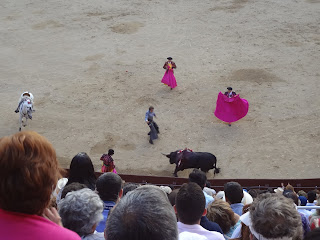** WARNING: This post is not for the faint of heart. **
Bullfighting has a long-standing history in Spanish culture and
While we were in Madrid, we wanted to attend a bullfight.
As it turns our, the timing of our trip was such that we would be in Madrid during the annual San Isidro festival which brings together the best fighters, bulls and aficionados. There are fights every day for 20 days, starting at 7 o'clock in the evening. The festival includes a variety of different fights, with novillos (young bulls), rejones (bullfights on horseback) and Goyesca fights (in period costume)
We were only able to attend an event on Sunday and the type that was scheduled was a corrida de rejones: A rejoneador (lancer) on horseback tries to stab the bull with javelins called rejones de castigo in the first stage and banderillas in the second. In the final stage, the rejoneador kills the bull with a rejón de muerte (lance of death). On some occasions, the rejoneador will kill the bull on foot in the traditional way with muleta and estoca.
We were a little skeptical of this the experience as we anticipated the "traditional/classic" style with the matador and cape. But, we had to take what we could get since it was the only time we could attend.
Prior to the bullfight, we had a wonderful guided city tour and will do a post in the future on that. We arrived at Plaza de Toros de Las Ventanas (the bullfight arena) about 30 minutes before it was scheduled to start. Similar to what we're used to for football games, there were vendors outside (but no tailgating).
While there aren't any skyboxes, they do have reserved seating for dignitaries. We were in luck that HRH la Infanta Elena was attending! The oldest daughter of the King and Queen is a big fan of bullfighting.
 |
| HRH Elena is in the grey suit in the middle of the white viewing box. |
 |
| The three rejoneadors. |
 |
| Teams of matadors. |
 |
| The team of horses for removing the bull. |
 |
| Tradition includes the rejoneadors making a pass around the ring waving to the spectators. |
 |
| Matadors with their capes. |
 |
| Three of the premier rejoneadors, many of whom have carried on the family tradition. |
 |
| The first of 6 bulls. |
* A parade horse - physically attractive and disciplined
* A horse for the first tercio (entrance of bull) - very fast and brave.
* A horse for the second tercio (banderillas) - fast, agile, and a natural instinct for fooling the bull
* A horse for the third tercio (death of bull) - very steady
The horses are trained and skilled in dressage.
 |
| Bulls are colorblind, but are attracted/distracted by movement of the cape. Shortly after trying to find this matador, the bull tried to jump the fence. |
**WARNING: Some of the following pictures may not be for the faint of heart.**
 |
| The final stage. |
 |
| Hermosa de Mendoza, a well-known rejoneador. |
 |
| Coming to get the bull. |
 |
| The crowd very pleased with Mendoza's fight and waives white cloths to signal he should be awarded an ear of the bull. |
 |
| Removing the bull. |
 |
| He was awarded the ear and parades around the ring. Many participants throw things toward him as congratulations. |
 |
| A very proud horse, taking a bow. This particular horse had lots of personality! |
So, in the end I'm glad we went and I'm glad we were able to see this type of fight where you get to see the skill of the fighter handling both the horse and bull. And now we can check this off the Bucket List.






